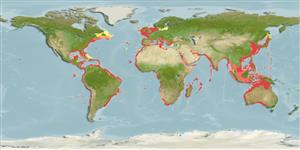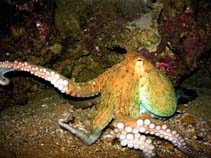Octopus vulgaris Cuvier, 1797
Common octopus| Native range | All suitable habitat | Point map | Year 2050 |

|
| This map was computer-generated and has not yet been reviewed. |
| Octopus vulgaris AquaMaps Data sources: GBIF OBIS |
Classification / Names Common names | Synonyms | CoL | ITIS | WoRMS
| Octopoda | Octopodidae | Octopodinae
Environment: milieu / climate zone / depth range / distribution range นิเวศวิทยา
เกี่ยวกับหินโสโครก; สัตว์น้ำที่อาศัยและอพยพภายในทะเลเท่านั้น (Ref. 75927); ระดับความลึก 0 - 347 m (Ref. 417), usually 0 - 100 m (Ref. 1977). Tropical; ? - 7°C (Ref. 275), preferred 26°C (Ref. 107945); 57°N - 38°S, 98°W - 146°E (Ref. 275)
การแพร่กระจาย ประเทศต่างๆ | พื้นที่จำแนกตาม FAO | ระบบนิเวศหลายระบบ | การปรากฏขึ้น,การเกิดขึ้น,พบ | การแนะนำ
Circumglobal in temperate and tropical seas.
Length at first maturity / ขนาด / น้ำหนัก / Age
Maturity: Lm ?, range 8 - 11.3 cm Max length : 180 cm TL เพศผู้/กระเทย; (Ref. 104052); 120 cm TL (female); น้ำหนักสูงสุดที่มีการรายงาน: 10.0 kg (Ref. 275)
Maximum common depth is 150 m in Ref. 75927. Maximum depth range from Ref. 114857. Maximum length for female from Ref. 804. This octopus is taken by amateur fishers and in small to large-scale harvest throughout its range. The greatest fishery effort occurs off northwest Africa, and it is know as one of the most valuable octopod species throughout the Mediterranean Sea where it is marketed fresh or frozen (Ref. 96968). Inhabits rocky, sandy and muddy bottoms of the coastline to the edge of the continental shelf (Ref. 2133). Found in intertidal and subtidal areas (Ref. 83938).
Life cycle and mating behavior วัยเจริญพันธุ์ | การสืบพันธุ์ | การวางไข่ | เซลสืบพันธ์ของเพศเมีย(ไข่) | ความดกของไข่ | ตัวอ่อน
Members of the class Cephalopoda are gonochoric. Male and female adults usually die shortly after spawning and brooding, respectively. Mating behavior: Males perform various displays to attract potential females for copulation. During copulation, male grasp the female and inserts the hectocotylus into the female's mantle cavity where fertilization usually occurs. Life cycle: Embryos hatch into planktonic stage and live for some time before they grow larger and take up a benthic existence as adults.
Main reference
อ้างอิง | ผู้ประสานงาน | ผู้ร่วมมือ
Roper, C.F.E., M.J. Sweeney and C.E. Nauen. 1984. (Ref. 275)
IUCN Red List Status (Ref. 130435)
Least Concern (LC) ; Date assessed: 08 April 2016
CITES status (Ref. 108899)
Not Evaluated
CMS (Ref. 116361)
Not Evaluated
Threat to humans
Human uses
การประมง: การค้า
FAO - การประมง: landings, species profile | FIRMS (Stock assessments) | FishSource | ทะเลรอบๆเรา
เครื่องมือ
ข้อมูลเพิ่มเติม
ประเทศต่างๆ
พื้นที่จำแนกตาม FAO
ระบบนิเวศหลายระบบ
การปรากฏขึ้น,การเกิดขึ้น,พบ
การแนะนำ
Stocks
นิเวศวิทยา
อาหาร, โภชนาการ
รายการอาหาร
พื้นที่จำแนกตาม FAO
ระบบนิเวศหลายระบบ
การปรากฏขึ้น,การเกิดขึ้น,พบ
การแนะนำ
Stocks
นิเวศวิทยา
อาหาร, โภชนาการ
รายการอาหาร
ชื่อสามัญ
ชื่อพ้อง
ผู้ล่า
การสืบพันธุ์
วัยเจริญพันธุ์
การวางไข่
ความดกของไข่
เซลสืบพันธ์ของเพศเมีย(ไข่)
Egg development
ชื่อพ้อง
ผู้ล่า
การสืบพันธุ์
วัยเจริญพันธุ์
การวางไข่
ความดกของไข่
เซลสืบพันธ์ของเพศเมีย(ไข่)
Egg development
แหล่งที่มาจากอินเตอร์เน็ต
BHL | BOLD Systems | CISTI | DiscoverLife | FAO(การประมง: species profile; publication : search) | Fishipedia | GenBank (genome, nucleotide) | GloBI | Gomexsi | Google Books | Google Scholar | Google | PubMed | แผนภูมิชีวิตแบบต้นไม้ | Wikipedia (Go, ค้นหา) | บันทึกทางด้านสัตววิทยา
Estimates based on models
Preferred temperature
(Ref. 115969): 10 - 28.9, mean 25.8 (based on 8514 cells).
ความสามารถในการกลับคืนสู่ปกติ
(Ref. 69278):
ความสูง, เวลาต่ำสุดที่จะทำให้ประชากรเพิ่มขึ้นเป็น 2 เท่าใช้เวลาน้อยกว่า 15 เดือน (K=0.38-0.72; tm=1.2).
Prior r = 0.77, 95% CL = 0.51 - 1.15, Based on 4 full stock assessments.
Nutrients: Calcium = 126 [75, 177] mg/100g; Iron = 4.79 [1.67, 7.92] mg/100g; Protein = 15.5 [13.7, 17.4] %; Omega3 = 0.414 [0.262, 0.566] g/100g; Selenium = 57.8 [48.5, 67.2] μg/100g; VitaminA = 0 μg/100g; Zinc = 1.97 [0.92, 3.02] mg/100g (wet weight).



